
Dear chic community,
As our trip to China comes to an end, it is time for some reflection in this special blog post. This post will be centered around the notion of “sharing economy” and will cover some of its aspects. In particular, we will try to compare when possible the similarities and differences between Hong-Kong and Shenzhen. Indeed, although these two cities are neighbors and share a border, they are not ruled by the same system and have a different history. This blog post will discuss a bit more Shenzhen since we spent most of our time there, but we will leverage the few days we spent in Hong-Kong to add information. As Shenzhen was once only dedicated to hardware manufacturing and Hong-Kong historically an important place for finance as well as import-export through it’s harbor, we will try to see how this legacy as well as their latest evolution in ambition or economic direction shaped their “sharing economy”.
Shared spaces and transportation
During the first part of our trip to Shenzhen we noticed that the city has a highly developed in public transport system. We tested several type of transport including two that could be relevant to share with you. The first is the self-service bike system. Each bike is geolocated in the city, it is enough to find one thanks to its application, to use it then to rest it where one wishes when one no longer needs it. This system seems to be a positive point in a big city like Shenzhen. It avoids a number of environmental nuisances in terms of greenhouse gases, local pollution, noise. But also to decongest public transport and traffic. As a result, this type of system is perceived by users as an additional transportation offer.
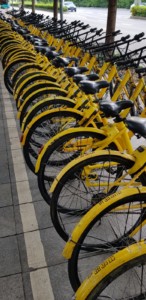
The second is a more unusual ways of transport. This is a very typical “taxi” scooter in China. For the little story we were a group of 4 students looking for a taxi in the center of Shenzhen, but it was getting late and taxis were scarce. After a moment of waiting we see two scooter docking us proposing to transport me (Marjane), Simone, Vignesh and Romain : two per vehicle, so three counting the driver. We were both exciting and frightened by this new way of transportation available to us. So we did not hesitate (to go/to drive) with him all together an unforgettable experience.
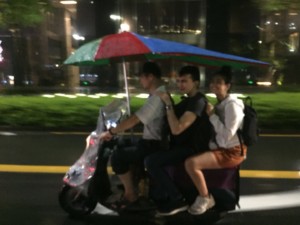
On the other hand, we had another experience in Shenzhen, specifically in Tencent. We had the chance to visit the premises of the company and we discovered at the reception a amazing electronic bookseller. It is totally free and allows you to share books between all employees of the company. We were pleasantly surprised by this very positive initiative, which not only can create links between employees but can also be seen as a place for discussion and sharing.
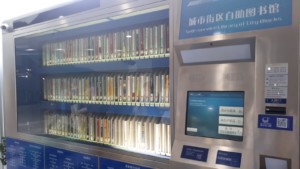
Makerspaces
In recent years, the Chinese government has promoted and supported a lot of makerspaces. Usually when we think about makerspaces in Switzerland we think about a place where hobbyists can use equipment to realise personal projects. In Shenzhen however the definition is not quite the same. Makerspaces are a place that provide working areas to professionals where they can work on commercial project. Such places not only provide prototyping equipment but also support and guidance in engineering and design especially focused on hardware and design for manufacturing. The x.factory is the perfect example of Shenzhen makerspaces. Having spent two weeks there we had the opportunity to use the facilities (3D printing, CNC machines, etc.) provided and benefit from the help provided by the staffs. Every time we needed information on how to get a part, or how to manufacture something specific, there was someone there to give us advise regarding our questions.
The people we met there where usually people with a startup that needed a place to work and develop their product in Shenzhen, or they had a finished product which they needed to adapt for manufacturing and where keen on receiving advises on how to do it the best way. Makerspaces are really representative of a sharing economy. Indeed, people come there to use shared facilities and equipment that they couldn’t afford individually. They can also benefit from the experience of others, be it staff in the makerspace that can provided some expertise, or other people working there and sharing their experience. Although the government spends some money helping these makerspaces, it actually supports a lot the innovation and creates value in the economy either directly with new
or disruptive products or indirectly by providing experience to (usually) young talents.
In Hong-Kong, the definition of the makerspace is very similar to that of Switzerland or Europe in general. Contrary to Shenzhen, makerspaces are usually oriented towards hobbyists, providing them with basic equipment to fulfill their personal projects. People going to such makerspaces usually do not make a living from the work they do there, but rather see it as a side activity to unleash their creative potential.
We visited two different makerspaces in Hong-Kong, Makerbay and Dim Sun Makerspace. These two makerspaces have a very different mood and attract a different audience. It is actually an important specificity of Hong-Kong makerspaces: they usually stand for some core values and support specific projects in adequation to these. For instance, Makerbay is oriented towards social and environmental issues and supports projects such as a “water drone” to map the coral reefs or an artist working only with recycled materials. Dim Sun makerspace on the other hand has a political fiber, and tries to promote the difference between Hong-Kong and mainland China.

Dim Sun

Makerbay
Accelerators
An other important player in the sharing economy landscape of both Shenzhen and Hong-Kong is accelerators. During the stay we visited two accelerators, one in Hong-Kong and one in Shenzhen which illustrate pretty well the differences of orientation of the two cities. The first accelerator we visited is Hax in Shenzhen, which is one of the top hardware accelerators in tge world. Hax supports a lot of projects financially, but also offers assistance to the incubated startups so they can be target their market, adapt their products to the consumers and of course adapt their products to mass manufacturing.
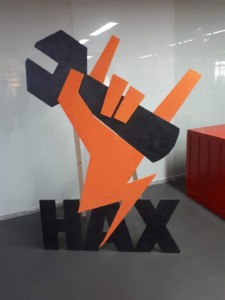
The second accelerator we visited was Brinc in Hong-Kong. Brinc is an IoT oriented accelerator. The core difference with Hax is that they do not focus on the hardware but more on the service that can be enabled through IoT devices. They noy only help startups with fundings, but they also help them harness the data provided by their product to their best potential.
Accelerators are similarly to makerspaces a very good environment for innovation and economic opportunities. In Shenzhen, they represent the more and more important presence of China in the innovation landscape, and in Hong-Kong they denote an ambition to develop new opportunities besides finance and import-export.

The shared economy behind copies
One of the most surprising thing about Shenzhen to us was the relationship people had to product copies, whether simple copycats or variations of an original brand product. In Europe, we usually have a bad opinion of copies or counterfeit products. We see them as unfair competition and an easy solution to make money. In Shenzhen, people are in a very different mindset and do not consider that an idea belongs to its creator. In fact when we wandered around Huaquiangbei (the electronic market), we could see a lot of trendy (in China) consumer products such as goPros. Not only were there a lot of cheap copies, but also a lot of varying products with more or less useful additional features. For instance there were some that incorporated two slots for SD cards. In Shenzhen, when a product is popular it doesn’t take long until copies appear, and its actually well integrated in the minds of entrepreneurs, makers or businessmen. During our pitches in Shenzhen, a lot of questions where related to how we differentiate from the competition and our strategy against copycats. In fact, in Hax, we were told that it is important to build a brand which is one of the best ways to be protected against copycats.
In Hong-Kong, the mindset is again very European in regards to copies, but since the economy is much less centered on hardware it is much less critical. It was however very interesting to see that sellers in markets in Hong-Kong were more keen on pretending there products were genuine when they are obviously counterfeit whereas in Shenzhen sellers where not even pretending to sell original brand products although they used logos of famous brand such as Apple or SanDisk.
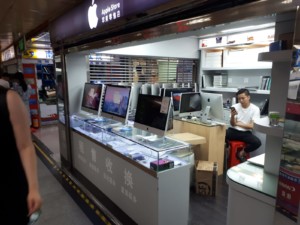
Conclusion
It is fair to say that both Shenzhen and Hong-Kong economy rely heavily on a sharing culture that provides not only great opportunities to talented individuals, but also provides a highly innovative environment which is very positive. Makerspaces and accelerators have flourished in recent years in the two cities which is one of the most relevant indicator of this notion of sharing of ideas, talents, experiences and expertise.

